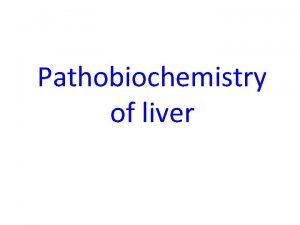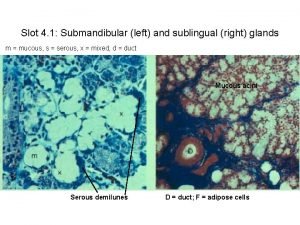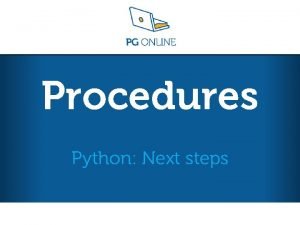Central Vein in the Clinic Next Steps Daniel



















- Slides: 19

Central Vein in the Clinic Next Steps Daniel Ontaneda MD MSc Cleveland Clinic Mellen Center for Multiple Sclerosis

Disclosures • Grant Support: NIH, Race to Erase, Patient Centered Outcome Research Institute, National Multiple Sclerosis Society, Genentech, Genzyme, Novartis. Consulting Biogen Idec, Genentech, Novartis. • Work presented was supported by Race to Erase MS Foundation

Challenges in diagnosis and misdiagnosis • Costs associated with MS total over $48. 4 billion annually, and 40% of direct care expense is related to disease modifying therapy (DMT) cost. 1 • Up to 20% of individuals referred for a diagnosis of MS are incorrectly diagnosed with MS. 2 • >2/3 of misdiagnosed patients are exposed to unnecessary and sometimes life-threatening risks associated with DMTs 2 1. Gooch CL. The burden of neurological disease in the United States: A summary report and call to action. Ann Neurol 2017; 81: 479– 84. 2. Solomon AJ, The contemporary spectrum of multiple sclerosis misdiagnosis: A multicenter study. Neurology 2016; 87: 1393– 9.

MS DMT in misdiagnosis 1. Kaisey. Incidence of multiple sclerosis misdiagnosis in referrals to two academic centers. MSARD, 2018; 30: 51 -56

MRI as a diagnostic biomarker • MRI is a sensitive tool for diagnosis of MS and is an integral component of the diagnostic criteria for multiple sclerosis. 1 1. Thompson AJ. Diagnosis of multiple sclerosis: 2017 revisions of the Mc. Donald criteria. The Lancet. Neurology 2018; 17: 162– 73.

Problems with MRI implementation • Approximately half of individuals referred to an MS clinic, present with atypical syndromes (not typical clinically isolated syndrome). 1 • Increasing diagnostic sensitivity may have come at the price of decreased specificity. 2 • MRI criteria have specificity of 32% for dissemination in space (DIS) and 42% for dissemination in time (DIT). 3 1. Kelly SB. Using atypical symptoms and red flags to identify non-demyelinating disease. J Neurol Neurosurg Psychiatry 2012; 83: 44– 8 2. Rommer PS. Applying the 2017 Mc. Donald diagnostic criteria for multiple sclerosis. Lancet Neurol 2018; 17: 497– 8. 3. Filippi M, Prediction of a multiple sclerosis diagnosis in patients with clinically isolated syndrome using the 2016 MAGNIMS and 2010 Mc. Donald criteria: a retrospective study. Lancet Neurol 2018; 17: 133– 42.

MRI/Central Vein • Misdiagnosis appears to be mainly due to over interpretation of abnormal MRI findings • CVS may differentiate: • • 85% of white matter lesions in MS 12 8% small vessel ischemic disease 13 34 % Migraine 14 14% Other inflammatory or autoimmune diseases 12 Sati, Nature Reviews Neurology 2016 1. Maggi P. Central vein sign differentiates Multiple Sclerosis from central nervous system inflammatory vasculopathies. Ann Neurol 2018; 83: 283– 94. 2. Mistry N. Imaging central veins in brain lesions with 3 -T T 2*-weighted magnetic resonance imaging differentiates multiple sclerosis from microangiopathic brain lesions. Mult Scler 2016; 22: 1289– 96. 3. Solomon AJ. ‘Central vessel sign’ on 3 T FLAIR* MRI for the differentiation of multiple sclerosis from migraine. Ann Clin Transl Neurol 2015; 3: 82– 7.

Central Vein: Next Steps • There is a significant unmet need for more specific and accurate diagnostic tests to facilitate early confirmation of a diagnosis of MS. • We propose a prospective evaluation of the central vein sign (CVS) — which we hypothesize will reduce misdiagnosis, hasten early diagnosis, and simplify clinical decision-making.

Centr. Al Vein Sign in MS (CAVS-MS) • Multi-center prospective observational study • Cross-sectional initial pilot study across 10 sites • Establish feasibility of CVS implementation in a multi-site study

Aims Primary Objective: • Establish the CNR of lesion-to-NAWM and central vein-to-lesion across the 10 different sites using 3 T FLAIR* imaging in subjects with a clinical or radiological suspicion of MS. Secondary Objectives: • Investigate the difference in CNR identified in the primary objective between precontrast FLAIR* imaging and post contrast FLAIR* imaging to identify whether gadolinium injection is required for central vein detection. • Determine the reproducibility of different methods for detection of positive CVS across sites. • Determine the sensitivity and specificity of the different methods for the diagnosis of MS compared to the Mc. Donald 2010 MS criteria.

Study Population • Individuals referred to an MS center based on a clinical or radiological suspicion of MS • Broad inclusion criteria, total sample size 30 • Sites • • • Cleveland Clinic Johns Hopkins University of California San Francisco University of Texas Houston University of Toronto (St. Michael’s Hospital) University of Vermont • • University of Southern California Cedars Sinai Yale University of Pennsylvania

Progress • Study funded by Race to Erase MS Foundation • 30 subjects enrolled across the different sites • Development of software platform for rating of central veins through imaging software partner: QMENTA • Study coordination Cleveland Clinic • Central image analysis at NIH (Reich/Sati) • Statistical analysis University of Pennsylvania (Shinohara)

Creation of FLAIR *

Lesion Segmentation

CVS rating

Prospective Study AIMS • Aim 1: To determine if incorporation of CVS for the diagnosis of MS improves diagnostic accuracy and hastens diagnosis in individuals presenting with typical first clinical events. • Aim 2: To determine if incorporation of CVS for the diagnosis of MS improves specificity among individuals presenting with atypical syndromes. • Aim 3: Central vein as a predictor of clinical/MRI disease activity associated with disability in MS.

Conclusions • Low specificity and misuse of diagnostic criteria may expose mis diagnosed patients to risk and increase health care costs • Central vein sign is a tool that offers promise both for increasing specificity, and perhaps enabling earlier diagnosis of MS. • Studies will determine if central vein sign can be incorporated into the diagnostic criteria • NIH is working with MRI manufacturers to make sequences available for disseminated clinical use

Acknowledgements • NAIMS • NIH • Pascal Sati, Danny Reich • University of Pennsylvania • Taki Shinohara • University of Vermont • Andy Solomon • Cedars Sinai • Nancy Sicotte

QUESTIONS
 X.next = x.next.next
X.next = x.next.next Liver blood supply diagram
Liver blood supply diagram Glucuronation
Glucuronation Elimination vs clearance
Elimination vs clearance Liver sinusoids
Liver sinusoids Liver central vein
Liver central vein Brigance transition skills inventory
Brigance transition skills inventory Macmillan next steps
Macmillan next steps Python next steps
Python next steps What is procedure in python
What is procedure in python Next steps with academic conversations
Next steps with academic conversations Next steps with academic conversations
Next steps with academic conversations Types of axial movement
Types of axial movement Hát kết hợp bộ gõ cơ thể
Hát kết hợp bộ gõ cơ thể Ng-html
Ng-html Bổ thể
Bổ thể Tỉ lệ cơ thể trẻ em
Tỉ lệ cơ thể trẻ em Chó sói
Chó sói Tư thế worm breton
Tư thế worm breton Chúa sống lại
Chúa sống lại





































